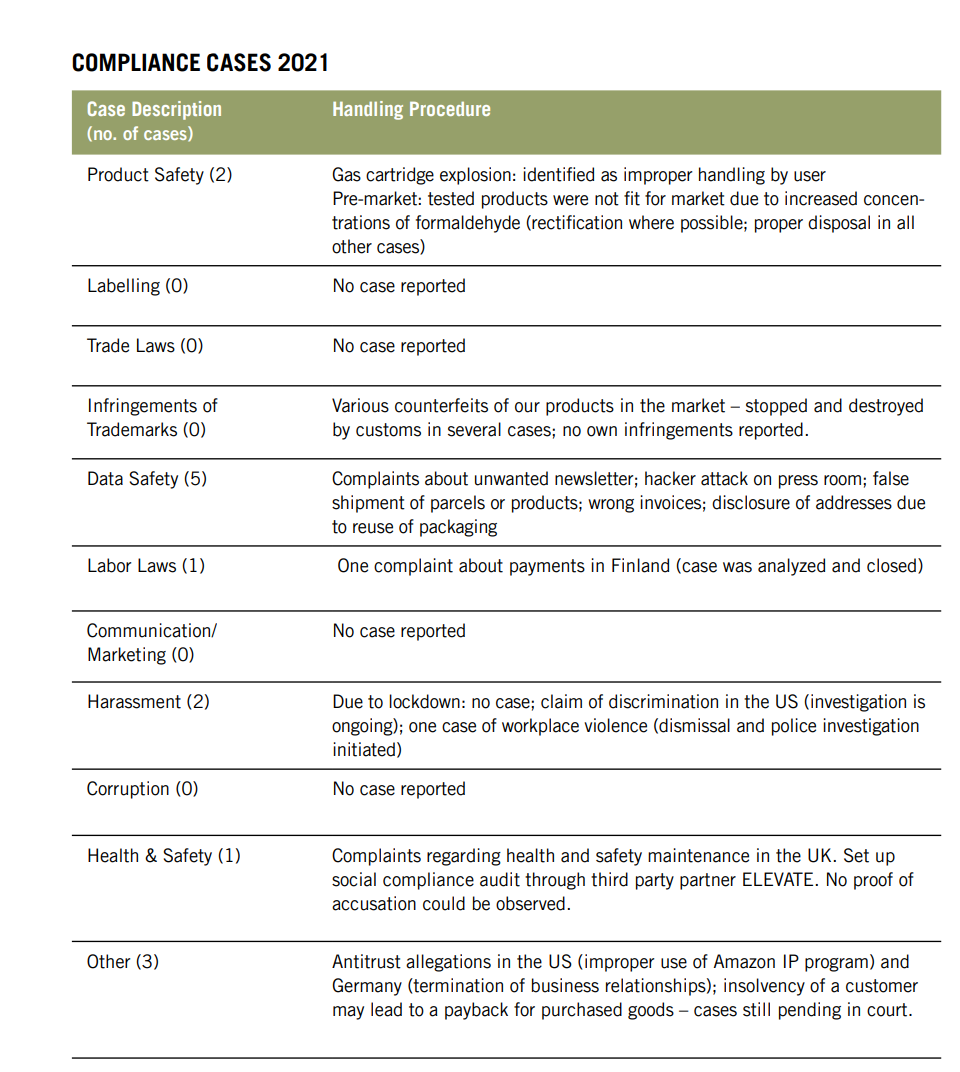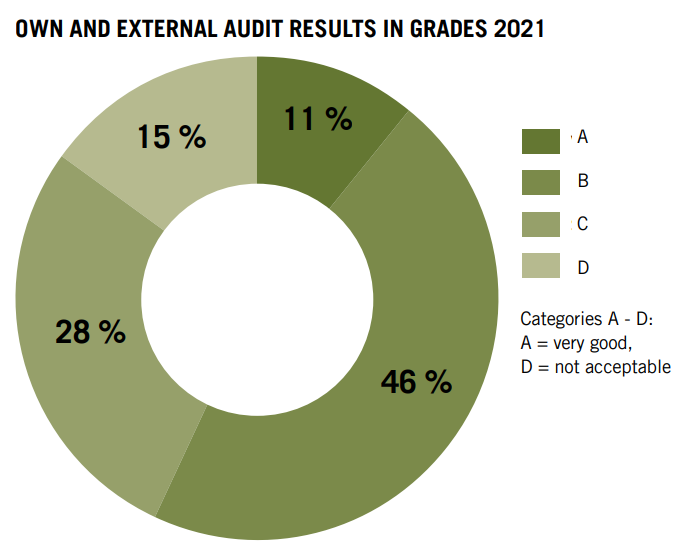14. Employment Rights
en
The company reports on how it complies with nationally and internationally recognised standards relating to employee rights as well as on how it fosters staff involvement in the company and in sustainability management, what goals it has set itself in this regard, what results it has achieved thus far and where it sees risks.
We remain committed to the principles of the UN Global Compact.
Most of our staff members operate under German, Swedish, Dutch, US and Finnish laws and the companies in our Group comply with national laws.
Adhering to laws are central to how we conduct our business. We require compliance with our Code of Conduct and we try to ensure that our employees and business partners share the same understanding of compliant behavior and business dealings. We introduced a compliance management system in 2012, and we are continuously improving and developing this system. As part of the compliance system, all managers are obliged to sign and declare on an annual basis that they are following the compliance rules and that their staff members are aware of the system. Among other things we have introduced remote management learning sessions, a skill mapping tool, a leadership program and to Covid-19 we have also introduced home office at all locations where possible. In 2022 we plan to strengthen these programs further.
In 2019, Fenix Outdoor took new bold steps towards sustainability. In line with that, we updated our
Fenix Way, our corporate governance policy in which all our values and goals are described as the strategic CSR agenda 2025. Fenix Outdoor has defined four major CSR pillars and set up single goals in order to achieve success in those. Every Fenix brand has defined their individual goals in order to support the strategy of the holding. Each goal is being reflected on a yearly basis by the CSO.
In order to reach every employee, the CSO and HR team do trainings on a yearly basis to keep everyone informed about the employee governance set up. These are the goals: Every employee knows about the Fenix Way; whom to reach out to in any case and that sustainability is one of Fenix core values.
In 2021, we provided each employee with an average of 30-plus hours in personal and technical training (2020: 10.7 hours per staff member), including training on CSR and compliance (n = 2 446). This training enables us to remain flexible, well-educated and skilled. We also intend for the training to inspire people and build up their qualifications for their current or new tasks.
The workplace should be safe and hygienic, and we take effective steps to prevent potential accidents and to minimize health risks as much as possible, particularly in our factories and logistical operations. Safety awareness is always a priority for us, and safe working procedures should be understood and implemented daily by everyone working in the factory. We ensure there are safety and handling instructions for operational equipment.
Next to setting up policies, we also do regular risk analyses in our supply chain. Through our social compliance system, we are aware of potential risks our partner are facing. In addition to that, we continuously mirror the spread in our supply chain to maintain security of our business.
For more detailed information also about the risks see
CSR Report 2021, pp. 3, 10, 27-28, 35
15. Equal Opportunities
en
The company discloses in what way it has implemented national and international processes and what goals it has for the promotion of equal opportunities and diversity, occupational health and safety, participation rights, the integration of migrants and people with disabilities, fair pay as well as a work-life balance and how it will achieve these.
Our policy is to promote equal opportunities for men and women, and our board expressly demands equal opportunity recruitment into managerial positions.
The proportion of female middle managers that Fenix Outdoor currently employs is 44.4% (2020: 41.6%), while the proportion of women in top management positions is 30 percent (2020: 24%). Our board is 17 percent female. The staff turnover rate in 2021 over all operations including the retail business is difficult to assess for the year, due to shop closures, short-time work or furloughs during the long lockdown periods and other factors. However, based on the data received, the turnover rate was about 44 percent (2020: 38%) reflecting the purchase of a new entity, the integration of a competitor in Denmark as well as the sell-off of Brunton. In Europe, we can establish a turnover rate of about 1.7%. The ratio between females and males leaving Fenix Outdoor dropped to 1.4: 1 F/M (2020: ratio F/M 1.7:1), meaning that roughly 58% of staff members leaving were females. All eligible staff members are entitled to parental leave (i.e., parents with children under a certain age). The definition differs from country to country, so an overall percentage value cannot be established. For our biggest operations, we have established that out of 126 eligible and affected employees (2020: 65), 77 returned after 12 months (2020: 32) while an additional nine stayed away beyond a 12-month period, but this data is not very reliable as there were parents who became parents another time and hence left again or stayed away longer than 12 months. Therefore, we are unable to assess how many of those who did not return after 12 months prolonged their leave to have another child.
Fenix Outdoor strives to take a non-discriminatory approach by paying equal wages to men and women, and by exceeding the minimum wage levels where possible. We hire local managers for the operations.
There are no defined goals of how to reach equal opportunities yet. In Sweden, we are monitored by the partners of the "kollektifavtal" and a 50:50 quota is legally required.
More information
CSR Report 2021 p. 34-35
16. Qualifications
en
The company discloses what goals it has set and what measures it has taken to promote the employability of all employees, i.e. the ability of all employees to participate in the working and professional world, and in view of adapting to demographic change, and where risks are seen.
At Fenix Outdoor, it is important for us that staff not only keep abreast with the latest developments and knowledge but that they also have an opportunity to develop themselves. In 2021 we provided each employee with an average of 30-plus hours in personal and technical training (2020: 10.7 hours per staff member), including training on CSR and compliance (n = 2 446). The trainings were given to female and male employees in equal numbers.
We also intend for the training to inspire people and build up their qualifications for their current or new tasks. Fenix Outdoor continued its trainee program for young professionals, now called Global Graduates. We hired three new global graduates in 2021. The original program started in 2011 with three management trainees. We also support our employees who want to develop their education, such as achieving MBAs.
Every year Fenix Outdoor offers its employees a chance to experience the outdoors and learn something about nature survival skills and the handling and functioning of our equipment while having a great time outdoors together. In some instances, participation in these events is part of the development curriculum or even mandatory. Nevertheless, most of our staff members are already active outdoor enthusiasts. To allow them to participate in outdoor activities and achieve a good work-life balance, individual arrangements are made between supervisors and their staff members.
There are no defined goals just yet. We do not see major demographic risk as we operate globally and are attractive to various age and gender groups in many nations.
More information
CSR Report 2021, p. 35.
Key Performance Indicators to criteria 14 to 16
en
Key Performance Indicator GRI SRS-403-9: Work-related injuries
The reporting organization shall report the following information:
a. For all employees:
i. The number and rate of fatalities as a result of work-related injury;
ii. The number and rate of high-consequence work-related injuries (excluding fatalities);
iii. The number and rate of recordable work-related injuries;
iv. The main types of work-related injury;
v. The number of hours worked.
b. For all workers who are not employees but whose work and/or workplace is controlled by the organization:
i. The number and rate of fatalities as a result of work-related injury;
ii. The number and rate of high-consequence work-related injuries (excluding fatalities);
iii. The number and rate of recordable work-related injuries;
iv. The main types of work-related injury;
v. The number of hours worked.
You will find the remaining numbers c-g of the indicator SRS 403-9 in the GRI standard and may additionally report them here.
Key Performance Indicator GRI SRS-403-10: Work-related ill health
The reporting organization shall report the following information:
a. For all employees:
i. The number of fatalities as a result of work-related ill health;
ii. The number of cases of recordable work-related ill health;
iii. The main types of work-related ill health.
b. For all workers who are not employees but whose work and/or workplace is controlled by the organization:
i. The number of fatalities as a result of work-related ill health;
ii. The number of cases of recordable work-related ill health;
iii. The main types of work-related ill health.
You will find the remaining numbers c-e of the indicator SRS 403-10 in the GRI standard and may additionally report them here.
Work-related injuries and Work-related ill health: A figure for days lost due to absenteeism (12 days in 2020) could not be established. There were 49 work-related injuries recorded, including bicycle accidents on the way to or from the workplace (2020: 1). No fatalities or work-related diseases were reported. Reported cases of work-related illness were about 26.
More information in
CSR Report 2021, p. 35
Key Performance Indicator GRI SRS-403-4: Worker participation on occupational health and safety
The reporting organization shall report the following information for employees and for workers who are not employees but whose work and/or workplace is controlled by the organization:
a. A description of the processes for worker participation and consultation in the development, implementation, and evaluation of the occupational health and safety management system, and for providing access to and communicating relevant information on occupational health and safety to workers.
b. Where formal joint management–worker health and safety committees exist, a description of their responsibilities, meeting frequency, decision-making authority, and whether and, if so, why any workers are not represented by these committees.
Worker participation on occupational health and safety: According to respective law and after risk assessment.
CSR Report 2021, p. 42
Key Performance Indicator GRI SRS-404-1: Average hours of training
The reporting organization shall report the following information:
a. Average hours of training that the organization’s employees have undertaken during the reporting period, by:
i. gender;
ii. employee category.
Fenix provided each employee with an average of 30-plus hours in personal and technical training (2020: 10.7 hours per staff member), including training on CSR and compliance (n = 2 446).
Total training hours invested: 79 003 HRS (all entities and all employees)
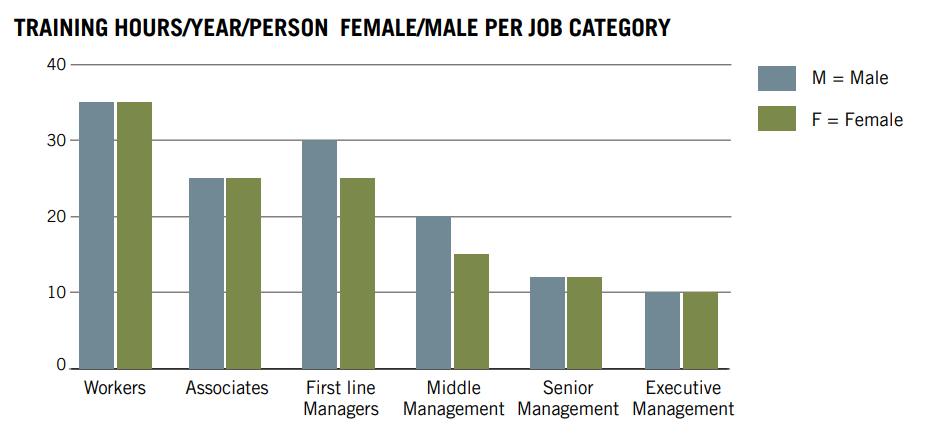
Key Performance Indicator GRI SRS-405-1: Diversity
The reporting organization shall report the following information:
a. Percentage of individuals within the organization’s governance bodies in each of the following diversity categories:
i. Gender;
ii. Age group: under 30 years old, 30-50 years old, over 50 years old;
iii. Other indicators of diversity where relevant (such as minority or vulnerable groups).
b. Percentage of employees per employee category in each of the following diversity categories:
i. Gender;
ii. Age group: under 30 years old, 30-50 years old, over 50 years old;
iii. Other indicators of diversity where relevant (such as minority or vulnerable groups).
Gender Diversity: The proportion of female middle managers that Fenix Outdoor currently employs is 44.4 percent (2020: 41.6 percent), while the proportion of women in top mangement positions is 30 percent (2020: 24 percent). Our board is 17 percent female.
The staff turnover rate in 2021 over all operations including the retail business is difficult to assess for the year, due to shop closures, short-time work or furloughs during the long lockdown periods and other factors. However, based on the data received, the turnover rate was about 44 percent (2020: 38 percent) reflecting the purchase of a new entity, the integration of a competitor in Denmark as well as the sell-off of Brunton. In Europe we can establish a turnover rate of about 1.7 percent. The ratio between females and males leaving Fenix Outdoor dropped to 1.4: 1 F/M (2020: ratio F/M 1.7:1), meaning that roughly 58 percent of staff members leaving were females.
Wages:
Fenix Outdoor strives to take a non-discriminatory approach by paying equal wages to men and women, and by exceeding the minimum wage levels where possible.
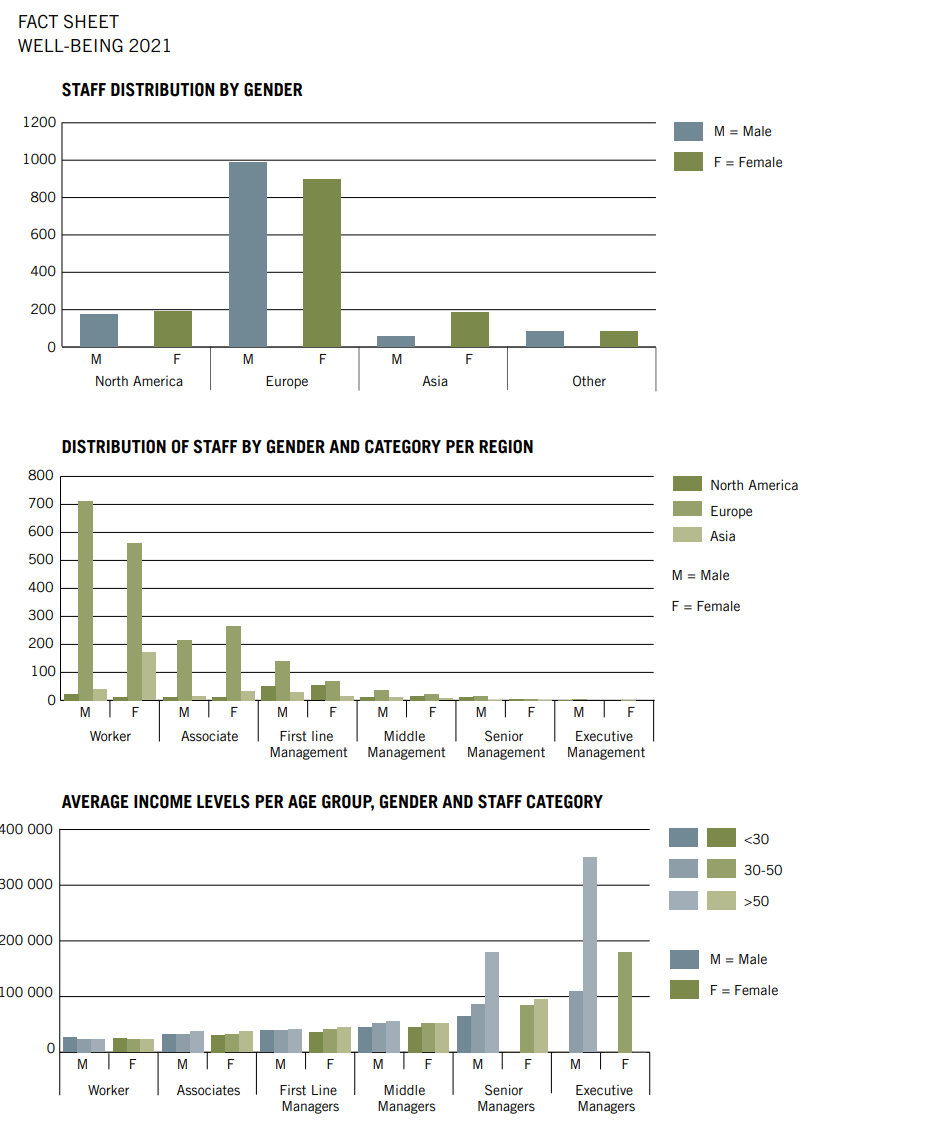 CSR Report 2021
CSR Report 2021, p. 34-35, 37
Key Performance Indicator GRI SRS-406-1: Incidents of discrimination
The reporting organization shall report the following information:
a. Total number of incidents of discrimination during the reporting period.
b. Status of the incidents and actions taken with reference to the following:
i. Incident reviewed by the organization;
ii. Remediation plans being implemented;
iii. Remediation plans that have been implemented, with results reviewed through routine internal management review processes;
iv. Incident no longer subject to action.
None, see
CSR Report 2021, p.42
17. Human Rights
en
The company discloses what measures it takes, strategies it pursues and targets it sets for itself and for the supply chain for ensuring that human rights are respected globally and that forced and child labour as well as all forms of exploitation are prevented. Information should also be provided on the results of the measures and on any relevant risks.
As a journey is only brought to life by the people participating, we strive to manage our societal impacts in a holistic manner.
The Fenix Way is the appropriate tool for us to address things which tend to fall behind when economic challenges arise.In the Fenix Way it is clearly stated that we follow the UN Global Compact and until now, the approach of zero child or forced labor was reached. This status is constantly proved by audits and surveys. Identified risks in the supply chain which were found through the social compliance system are shown in the
CSR Report 2021, p. 26-29 and 33.
Regarding the relationship with our suppliers in production, we have set up a clear due diligence process which follows the United Nations Guiding Principles on Business and Human Rights as well as the OECD Due Diligence Guidance for Responsible Business Conduct. Following these documents, the UN Global Compact and our own set of rules, we identify, try to prevent and mitigate actual and potential adverse impacts in our supply chain. Next to our audit system, Fenix Outdoor orients its production by its own country risk evaluation. This contains different factors around corruption, human rights and environment risks as business opportunities.
Since Fenix Outdoor is an accredited affiliate of the FLA, we audit our supply chain partners according to the Fenix Outdoor/FLA workplace standards. Our team of three social auditors is complemented outside of China and Vietnam by our third-party service partner, ELEVATE. Beside new suppliers that are always audited, in 2021 we were able to visit 55 production sites (2020: 75) and covered around 30 percent of our Tier 1 supplier base. This number decreased from the previous years due to several Covid-19 lockdowns and travel restrictions, mainly in Vietnam but also in China and European countries. We aim at increasing this number in 2022 since there are less Covid-19 restrictions. To make sure that fair labor conditions are being valued in these special times, Fenix Outdoor sent out additional questionnaires to Vietnamese production sites and kept in steady communication with the factory management. Besides regular social compliance audits, we support the approach to share social audits by using a common social framework. Therefore, we are an official signatory to the Social Labor Convergence Project (SLCP). Within our SAC membership, we use the Higg Facility Social Labor Module (FSLM) to request the SLCP assessments from our supplier to complement our own audit process, and in best cases the assessments get a verification. Another important aim is fostering the aspect of living wages. Until the end of last year, Fenix was the only company in the world that audited the majority of its suppliers regarding this important topic and engaged in individual dialogues with the factories. We serve as role models for many leading brands and companies in Europe.
Key Performance Indicators to criteria 17
en
Key Performance Indicator GRI SRS-412-3: Investment agreements subject to human rights screenings
The reporting organization shall report the following information:
a. Total number and percentage of significant investment agreements and contracts that include human rights clauses or that underwent human rights screening.
b. The definition used for ‘significant investment agreements’.
No such investment.
Key Performance Indicator GRI SRS-412-1: Operations subject to human rights reviews
The reporting organization shall report the following information:
a. Total number and percentage of operations that have been subject to human rights reviews or human rights impact assessments, by country.
100 % of our own operations as well as our supply chain partners all over the world are monitored on a regular basis by our Quality and social compliance teams.
Key Performance Indicator GRI SRS-414-1: New suppliers subject to social screening
The reporting organization shall report the following information:
a. Percentage of new suppliers that were screened using social criteria.
Key Performance Indicator GRI SRS-414-2: Social impacts in the supply chain
The reporting organization shall report the following information:
a. Number of suppliers assessed for social impacts.
b. Number of suppliers identified as having significant actual and potential negative social impacts.
c. Significant actual and potential negative social impacts identified in the supply chain.
d. Percentage of suppliers identified as having significant actual and potential negative social impacts with which improvements were agreed upon as a result of assessment.
e. Percentage of suppliers identified as having significant actual and potential negative social impacts with which relationships were terminated as a result of assessment, and why.
18. Corporate Citizenship
en
The company discloses how it contributes to corporate citizenship in the regions in which it conducts its core business activities.
Giving back to society is an essential part of good corporate citizenship and often forms part of the philanthropic side of CSR. Due to the corporate structure, we have a local and decentralized approach to corporate citizenship. However, for risk prevention and risk management purposes, the CEO has demanded that the CSO approves/disapproves all engagements of more than 2500 Euro to avoid reputational or compliance issues. The goal of the program is a local engagement that helps to better environmental and societal conditions.
As in past years, our retailers and brands supported a variety of nonprofit organizations with donations of money or products. To mention a few: The German Ramblers Association (Verband Deutscher Gebirgs- und Wandervereine e.V.) received donations from Fjällräven’s “Arctic Fox Initiative” and through “Green Week” (instead of Black Friday) at the German retailer Globetrotter. In total we have donated EUR 746 700.
Naturkompaniet's and Partioaitta`s large and growing customer club again contributed to local nature conservation. One percent of members’ total purchases is donated by Naturkompaniet and Partioaitta to various Swedish and Finnish nature and environmental conservation projects. Donations totaled more than 400 000 EUR, up 70 000 EUR from the previous year. To give an example, the CleanSea (cleansea.co) is one out of seven initiatives which received the Nature Bonus in 2021.
Key Performance Indicators to criteria 18
en
Key Performance Indicator GRI SRS-201-1: Direct economic value generated and distributed
The reporting organization shall report the following information:
a. Direct economic value generated and distributed (EVG&D) on an accruals basis, including the basic components for the organization’s global operations as listed below. If data are presented on a cash basis, report the justification for this decision in addition to reporting the following basic components:
i. Direct economic value generated: revenues;
ii. Economic value distributed: operating costs, employee wages and benefits, payments to providers of capital, payments to government by country, and community investments;
iii. Economic value retained: ‘direct economic value generated’ less ‘economic value distributed’.
b. Where significant, report EVG&D separately at country, regional, or market levels, and the criteria used for defining significance.
See
CSR Report 2021, p. 24, 25
19. Political Influence
en
All significant input relating to legislative procedures, all entries in lobby lists, all significant payments of membership fees, all contributions to governments as well as all donations to political parties and politicians should be disclosed by country in a differentiated way.
Over the past few years, we have built partnerships and reinforced existing relationships, and we did not change our network in 2021. Fenix Outdoor has been a reliable and constant signatory to and supporter of the UN Global Compact since 2012 and continues on a participant level for its further engagement. We are also committed to the Swedish Textile Initiative for Climate Action (STICA) and are cooperating in the North American market with the US-based Outdoor Industry Association in Climate Action Corps.
We continued our involvement in the Sustainable Apparel Coalition (SAC) and furthered the rollout of the Higg modules such as verifying the updated Brands and Retail Module (BRM) for two of our businesses for the first time.
As a member of the Fair Labor Association (FLA) we continuously develop our social compliance governance. We are committed to fair labor conditions and support the concept of a living wage.
Since 2015, Fenix Outdoor has also been a member of the Textile Exchange. Through this network, several Fenix Outdoor brands work together with peers and scientists to support activities and research in the area of recycling, the use of organic material, improved supply chain management and better choice of materials. In the annual benchmarking program, Fenix Outdoor brands regularly score high and often outperform numerous other reputable brands.
As in previous years, various entities of Fenix Outdoor are members of the European Outdoor Group (EOG), a trade association advocating the European Outdoor Industry’s interests.
Fjällräven is a member of the European Outdoor Conservation Association (EOCA). Fjällräven also supports the Swedish Textile Industry’s Initiative for Climate Action, organized through our long-term partner the Sustainable Fashion Academy.
When it comes to certification schemes, we do not aim for formalized certifications of any type of management systems. However, ISO 9000 and ISO 14000 principles are applied in most operations, and suppliers or certain materials often carry significant and reputable signs of conformity to industry standards, such as the Global Organic Textile Standard, bluesign or others.
Key Performance Indicators to criteria 19
en
Key Performance Indicator GRI SRS-415-1: Political contributions
The reporting organization shall report the following information:
a. Total monetary value of financial and in-kind political contributions made directly and indirectly by the organization by country and recipient/beneficiary.
b. If applicable, how the monetary value of in-kind contributions was estimated.
None.
20. Conduct that Complies with the Law and Policy
en
The company discloses which measures, standards, systems and processes are in place to prevent unlawful conduct and, in particular, corruption, how they are verified, which results have been achieved to date and where it sees there to be risks. The company depicts how corruption and other contraventions in the company are prevented and exposed and what sanctions are imposed.
Adhering to laws and regulations is central to how we conduct our business. We require compliance with our Code of Conduct and we try to ensure that our employees and business partners share the same understanding of compliant behavior and business dealings. We introduced a compliance management system in 2012, and we are continuously improving and developing this system.
The Fenix Outdoor CMS concept complies with the main prevailing standards, namely IDW PS 980 and ISO 19 600. As with our sustainability report, the CSO submits an annual compliance report to the CEO and the board. Following the Compliance Guidelines, the Chief Compliance Officer (CCO) submitted his annual report to the board in April 2021. In June 2021 he was also appointed Group Data Protection Officer. Through this move, various compliance and legal matters are dealt with in one place, streamlining the efforts under compliance even further. As part of the compliance system, all managers are obliged to sign and declare on an annual basis that they are following the compliance rules and that their staff members are aware of the system. For 2021 a total of 32 declarations were received.
Compliance in Fenix Outdoor is not only a result of the ethical principles mapped out in the Fenix Way and other internal documents. It also reflects the owners’ will to systematize the handling of ethical and legal matters. In 2021, the number of cases directly reported to the CSO increased slightly over 2020.
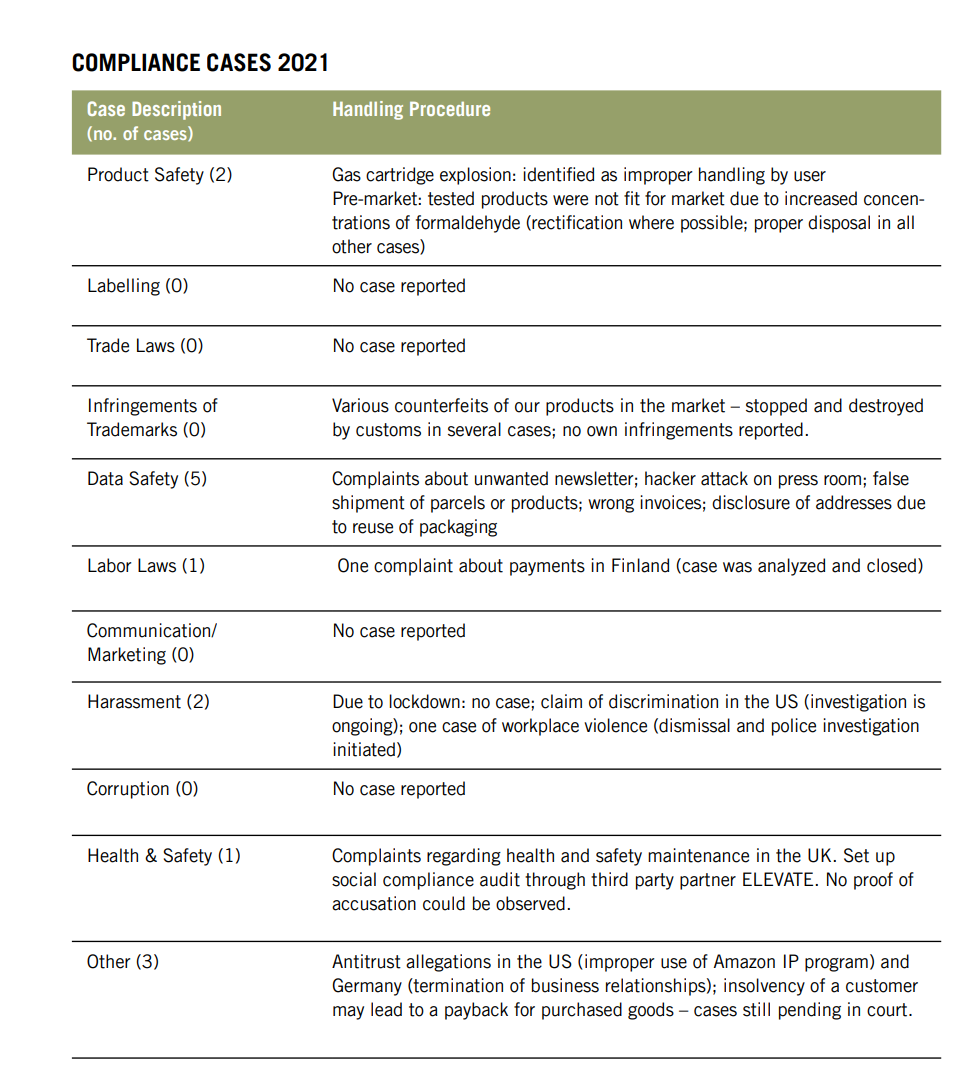
Key Performance Indicators to criteria 20
en
Key Performance Indicator GRI SRS-205-1: Operations assesed for risks related to corruption
The reporting organization shall report the following information:
a. Total number and percentage of operations assessed for risks related to corruption.
b. Significant risks related to corruption identified through the risk assessment.
100 %
Key Performance Indicator GRI SRS-205-3: Incidents of corruption
The reporting organization shall report the following information:
a. Total number and nature of confirmed incidents of corruption.
b. Total number of confirmed incidents in which employees were dismissed or disciplined for corruption.
c. Total number of confirmed incidents when contracts with business partners were terminated or not renewed due to violations related to corruption.
d. Public legal cases regarding corruption brought against the organization or its employees during the reporting period and the outcomes of such cases.
None
Key Performance Indicator GRI SRS-419-1: Non-compliance with laws and regulations
The reporting organization shall report the following information:
a. Significant fines and non-monetary sanctions for non-compliance with laws and/or regulations in the social and economic area in terms of:
i. total monetary value of significant fines;
ii. total number of non-monetary sanctions;
iii. cases brought through dispute resolution mechanisms.
b. If the organization has not identified any non-compliance with laws and/or regulations, a brief statement of this fact is sufficient.
c. The context against which significant fines and non-monetary sanctions were incurred.
See in the following table:
